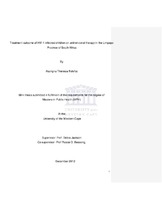| dc.contributor.advisor | Jackson, Debra | |
| dc.contributor.advisor | Bessong, Pascal O. | |
| dc.contributor.author | Folefoc, Asongna Theresia | |
| dc.date.accessioned | 2015-03-02T08:30:18Z | |
| dc.date.available | 2015-03-02T08:30:18Z | |
| dc.date.issued | 2012 | |
| dc.identifier.uri | http://hdl.handle.net/11394/4006 | |
| dc.description | Magister Public Health - MPH | en_US |
| dc.description.abstract | Background:HIV is a worldwide pandemic with an estimated 2.5 million children under the age of 15 living with HIV in the world in 2009. Children account for approximately 14% of all HIV-related deaths around the world. Several studies have shown that the use of antiretroviral drugs greatly improve the lives of
HIV-1 infected individuals, however, most of these studies report on outcomes of ART programmes in developed world and for adult patients. Very few settings have published outcomes of paediatric ART programmes.Objectives This research was aimed at describing the long term (at least one year) treatment outcome of HIV-1
infected children in the HIV/AIDS Prevention Group (HAPG) program in Bela-Bela in the Limpopo province of South Africa.Study design and methods: A quantitative approach involving a retrospective cohort design was used for the study. The study
included all children under the age of 15 that were enrolled in the HATG treatment programme in Bela-Bela between February 2004 and December2009.Immunological, virological, clinical outcomes and loss to follow-up were determined for this cohort. Mortality and survival was also determined.
Results: The median age of children in this study was 5 years (IQR: 2-7) with 14% (10/71) of them being less than 18 months. Median CD4 count at commencement of ART, viral load and weight were 358 cells/mm3 (IQR 203.5-, 125673 RNA copies/μL (IQR 58094-328424.5) and 14.5Kg (IQR: 11.0-18.35) respectively. CD4 counts and weight showed increase within the study period, and there was also a
decline in viral load. Loss to follow-up was 7.04% while mortality was 19% with 21.43% of mortality cases being children who were ≤18months. Mortality occurred within the first year of ART initiation and occurred in cases that had advanced disease.Conclusion: This study shows that the ART program in Bela-Bela has a positive outcome on HIV positive children.The high mortality rate was due to children starting ART at an advanced disease stage. Despite the good outcome, it is recommended that a system be put into place that will aid in identifying children at an early stage of the disease and treatment initiated promptly. | en_US |
| dc.language.iso | en | en_US |
| dc.publisher | University of the Western Cape | en_US |
| dc.subject | HIV | en_US |
| dc.subject | Antiretroviral drugs | en_US |
| dc.subject | ART programmes | en_US |
| dc.title | Treatment outcome of HIV-1 infected children on antiretroviral therapy in the Limpopo Province of South Africa | en_US |
| dc.type | Thesis | en_US |
| dc.rights.holder | University of the Western Cape | en_US |

